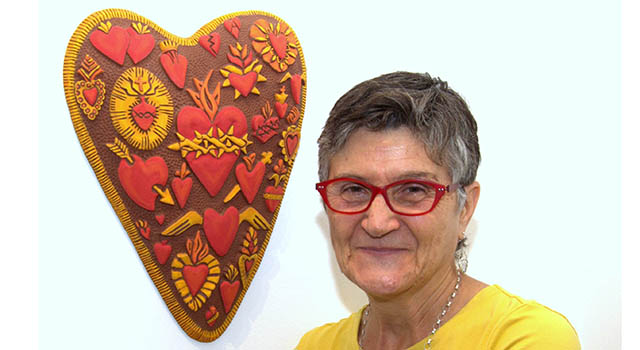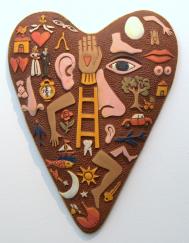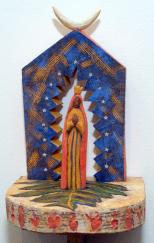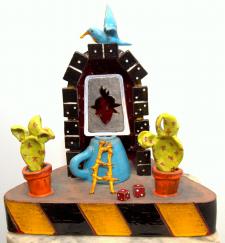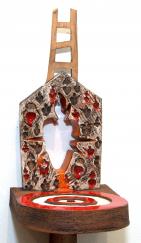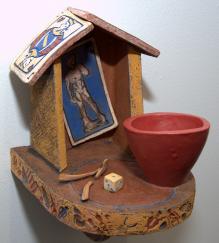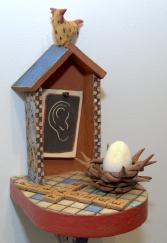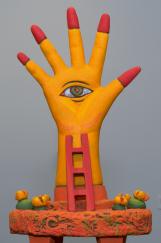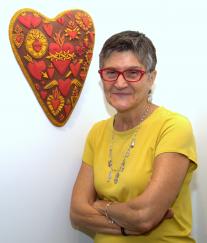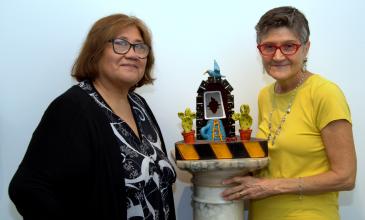By Jim Davis - Florida Catholic
Photography: JIM DAVIS | FC
MIAMI GARDENS | Much religious art tackles big issues: war, peace, miracles, biblical stories, the lives of saints. Angi Curreri's art leans toward the small: eggs, dice, birds, coffee mugs.
Rather than big issues, she prefers “Small Offerings” — the title of her exhibit at the Archbishop John C. Favalora Archive and Museum at St. Thomas University.
And rather than expansive canvases, she favors ceramic sculptures and bas-reliefs less than two feet tall.
“I think of my work as quiet, intimate,” Curreri, a professor of art at Barry University, said of the exhibit, which ends Dec. 14. “I've been given a gift, a voice, as an artist. This is the best of what I have to give back to the world.”
Step into the exhibition hall at St. Thomas, and you may think at first you're seeing a collection of birdhouses decorated with various objects. The artworks are in fact an echo of the small objects many traditional Catholics make.
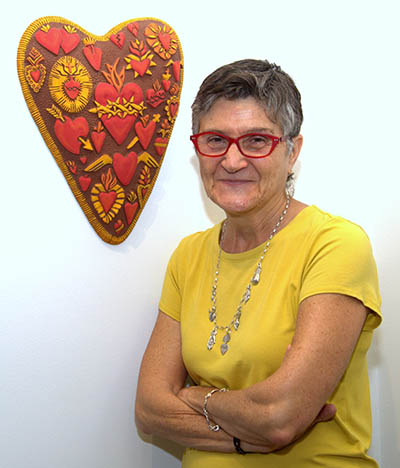
Photographer: JIM DAVIS | FC
Artist Angi Curreri poses with her ceramic sculpture "Heart of Hearts," part of her "Small Offerings" exhibit at St. Thomas University.
They include small, house-like shrines by roadsides in Italy. They also include “milagros,” symbolic objects in Latin America that tell God either “Help me” or “Thank you.”
Her goal is to show the many ways ordinary people infuse the divine into everyday life. “I want people to take a moment, to be quiet, to think about objects in their daily life,” Curreri said. “There's grace in all of it.”
SHRINES RE-IMAGINED
Many of Curreri's pieces hearken to roadside shrines in Europe and North America. But she also adds her own interpretations:
- Scrabble tiles crossing words like “pain” with “pleasure.” Curreri said she likes to blend opposite concepts.
- Ladders at the peaks of the tiny houses, connecting life and death, the physical and the spiritual.
- Playing cards, lying in front of the shrines or even roofing them. “My father played pinochle on Friday nights in Brooklyn,” Curreri said with a smile.
- Coffee cups, recalling desserts, birthdays and other home gatherings. Curreri even linked the cups with the Communion chalice — another way she says that grace can infuse everyday life.
Isabel Medina, curator and museum coordinator, said she wanted the exhibit to highlight Catholic artistic heritage at the common folk level.
“This is an important exhibit, a resurrection of Catholic traditions that have been kind of lost in the United States,” Peru-born Medina said. “People don't know about shrines and votives and offerings, and their artistry.”
But to focus on her specialty, Curreri had to leave home, then return.
FAITH-BASED IMAGERY
She was born in Brooklyn to an Italian family, then moved to Florida. She graduated from the University of Miami, then earned a master's degree in fine arts from the University of Kansas.
During her graduate school period, in the early 1980s, she came home on a visit. She was suddenly struck by how much the homes of her relatives were permeated by faith-based imagery, like a shrine of Our Lady of Lourdes in her grandmother's house.
That set off a search for identity, she said. “I had to find out how Italian, how Catholic and how American I was.”
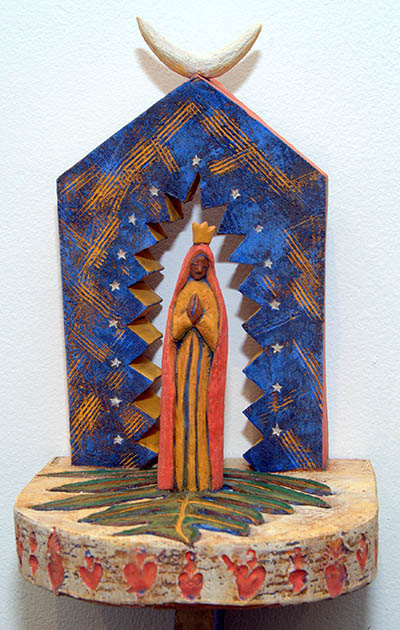
Photographer: JIM DAVIS | FC
"Small Offering -- Wall Shrine #12" centers on Our Lady of Guadalupe, in Angi Curreri's "Small Offerings" exhibit at St. Thomas University.
Traveling Italy in the Study Abroad program with the University of Georgia, Curreri saw the sacred spaces made by ordinary people — in homes, by doorways, even in businesses and roadsides. To her, the items were related to small holy objects like ex-votos in Europe and milagros in North America — and to formal religious artifacts like monstrances and reliquaries.
“Every street in Italy has shrines, mostly of the Madonna,” Curreri said. “And in Mexico, the homes are sometimes very small, yet the shrines are the focus.”
The STU exhibit features other artworks by Curreri, too. A half-dozen freestanding shrines are made of clay, decorated with intricate depressions. She took inspiration from an extended vacation in New Mexico, walking around Santa Fe and driving around the state.
A “Suspended Heart Shrine” sets the heart in a pointed archway, a clear churchly reference. A similar arch shelters a flattened Earth, resembling a Eucharistic host in a reliquary.
“I wanted to show the preciousness of the world and the need to protect,” Curreri explained.
RADIATING HEART
A couple of foot-tall “Radial Shrines” are pedestals supporting auras that are meant to evoke monstrances. A “Watchful Eye Shrine” has an eye on the palm, a radiating heart on the back.
“I like the element of surprise,” she said.
The two largest wall items are clay hearts, each 16 inches high. “Heart's Desire” is decorated with an arm, a leg, an eye, an ear, a foot, a boat, a plane, even a tooth — “all the things you go through in life,” Curreri said.
The other large item is a “Heart of Hearts,” with a variety of hearts embossed onto it — winged, aflame, pierced with an arrow, surrounded with an aura. They're copied from heart images she's collected from milagros, or church walls or cases.
Even non-Catholics create shrines, Curreri argued. They may not include crosses or madonnas; but they’ll place plaques at the sites of tragedies like the 9/11 attacks. She also mentioned roadside memorials, with pictures and flowers and teddy bears, after a crash or a shooting. She recalled visiting Oklahoma City before an official memorial was set up to commemorate the deadly 1995 bombing of a federal building.
“I saw a fence with flowers and beads stuck into it,” she said of the Oklahoma City site. “Those were votives. Whoever was behind them, they were sending a message to the people who were gone.”
Curreri said reactions thus far have been positive, but for different reasons. Catholics have remarked on the spiritual content, while non-Catholics have enjoyed the artistry, she said. The exhibit reaped praise during a recent day when two artist acquaintances dropped by.
“It's wonderful to see ceramics at this level,” said Bryan Hiveley, a ceramic artist from Miami. “And you can see her whole body of work, the vocabulary of an artist.”
Judith Berk, an artist based in Miami, praised the messages behind Curreri's art. “This isn't just pretty ceramics. It's ceramics with meaning.”
IF YOU GO
- Event: “Small Offerings,” art exhibit
- Featuring: Ceramic artworks showing infusion of the divine in everyday life
- When: Through Dec. 14
- Where: Archbishop John C. Favalora Archive and Museum at St. Thomas University
- Address: 16401 NW 37th Ave., Miami Gardens
- Hours: 10 a.m. to 6 p.m. Monday through Friday, Saturday by appointment
- Cost: Free
- Info: 305-628-6769
